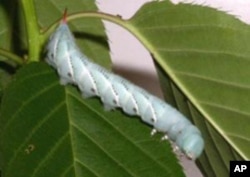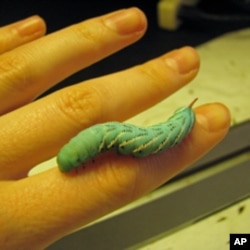By turning a powerful x-ray machine on a caterpillar, scientistists have discovered a novel way of movement that could inspire new robotics to help humans.
The common tobacco hawkmoth caterpillar was studied at the Argonne National Laboratory near Chicago.
Collaborator Jake Socha, an assistant professor of engineering at Virginia Tech, says peering inside with a conventional x-ray simply doesn't work because the animals are soft, squishy and boneless creatures.
"What's special about these x-rays is they are almost like a laser light. And, what that allows you to do is to hone in directly on something that is really small, like the body of a caterpillar and to see details in there that you would not see with your doctor's office x-ray."
The slow moving caterpillar was positioned on a custom-made treadmill.
On the move
Actually, it was a rubber band suspended between pulleys in the experiment room, explains team leader Michael Simon, a researcher in the Department of Biology at Tufts University.
"So all at the same time we have the caterpillar on the treadmill, which we have to control from the control room and we have the x-ray beam running through that and the visible light cameras so that we know what the caterpillar is doing," says Simon. "And it is by synchronizing all that information that we were able to determine what was going on inside the caterpillar."
What they saw, Simon says, looked like an open bag lined with muscle, with a simple digestive tube - or gut - running from head to rear. A finely branched network of air tubes supplying tissues with oxygen and venting carbon dioxide resembled waves of gently moving seaweed.
"But as soon as the caterpillar started crawling, it was as if the tide came in and these great branch structures began to dramatically swing back and forth as the caterpillar crawled and it was immediately apparent that something was moving around very dramatically inside the body."
Gut reaction
That "something" was the animal's gut. Simon says the strange thing about it was that it wasn't moving along with the body.
"The crawl would begin at the back of the animal and the gut would start moving forward immediately, even before the crawl wave had arrived at the middle of the animal. So we could predict the presence of a crawl wave in a couple seconds, based purely on internal movements."
This kind of two-bodied mechanical locomotion system - where the gut slides independently from the surrounding tissues - has never before been observed by scientists. Simon says the novel biological system could be applied to the design of soft-material robots.
"Soft robots would have some of the advantages that caterpillars have, their incredible mobility, their ability to squeeze their body into strange places, to enter weird contortions, to be able to follow very complicated topologies."
Human applications
A caterpillar-inspired robot could be used in various medical procedures or could wriggle into tight spaces to bring video cameras or even food and water to trapped survivors in the chaotic rubble of buildings flattened by an earthquake.
Michael Simon says he hadn't expected to make any new discoveries about how caterpillars crawl. And he says he's amazed what still can be learned from these simple, commonplace creatures.
Simon and his colleagues' article on caterpillar locomotion appears in the August issue of the journal Current Biology.

















